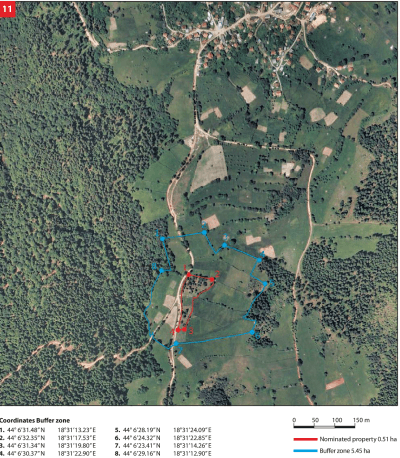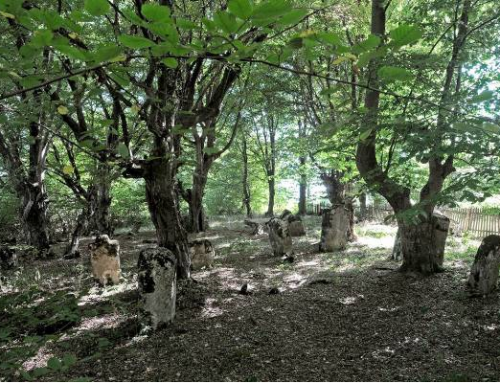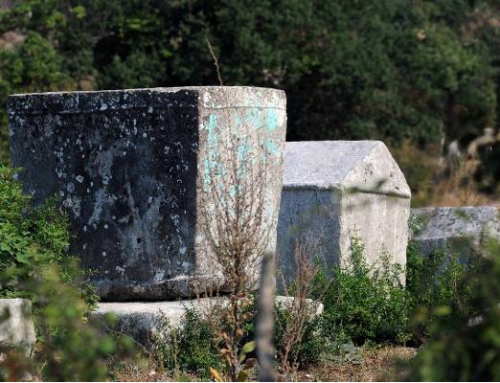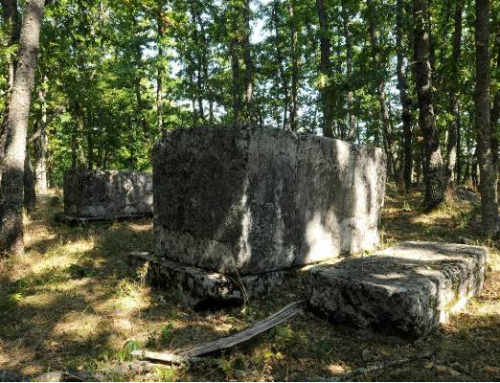About

The necropolis is situated in the village of Musići, about 4 km to the south-west of Olovo. The monuments lie west-east and north-south.
It has 80 tombstones: 25 slabs, 8 chests and 47 gabled roof monuments. Twelve are decorated: 2 slabs, 2 chests and 8 gable-roofed monuments.
The most common motifs are spirals, rosettes and twisted bands, followed by crosses.
No inscriptions have been recorded.
Growth and historical development of the area were determined by the abundance of ores and minerals. The old lead mine has been known since the time of Roman rule in Pannonia, Dalmatia and Illyria.
In the seventies of the 14th century mining in Bosnia develops intensively, at which time the work in the Olovo mine is revived. In the Middle Ages, the settlement of Olovo was established with the town named Olovac. The mine Kamenica is closely associated with Olovo and it was mentioned in the Dubrovnik documents in 1376.
Olovo was first mentioned in 1382 under the name ‘Olovo Plumbum’, and the name ‘città de Piombo’ was mentioned in 1415.
In the near and wider surroundings of Olovo, there are a large number of necropolises with tombstones. Apart from the necropolis in Musići, there are also necropolises in Slavanj, Križevći and Boganovići.
The whole ornamental system at the Olovo necropolises points to a special art school which had its own principles of decoration and its own way of designing ornamented surfaces.
In the 1950-ies the National Museum in Sarajevo began a systematic study of necropolises with tombstones in Bosnia and Herzegovina which included recording of the Olovo necropolises. There have been no archaeological excavations.
BA – Mramor in Musići, Olovo (11)
The village of Musići is about 4 km beeline south-west of Olovo. The necropolis is situated on a land plot within a pine forest near the village, slightly elevated, right next to a macadam road. The national monument site encompasses cadastral parcels 924 and 925 of the cadastral municipality of Klinčići, Municipality of Olovo, Federation of BiH, Bosnia and Herzegovina; private ownership.
Location
The necropolis is situated on a plot located in a pine forest near the village of Musići on slightly higher grounds next to a macadam road. The plot is surrounded by a wooden fence.
State of the location
The condition of the site is not satisfactory. There is no construction in the immediate vicinity. A large number of tombstones have evidently sunken and moved, and it is impossible to tell precisely whether the tombstones are presently in their original position. In many cases, the base is barely visible (most of them are sunken and covered by soil).
The tombstones are largely covered by plant organisms (moss and lichen), some of which negatively affect the stone structure, and one stećak is almost amorphous (the structure is destroyed by plant organisms). A few of the tombstones have been evidently mechanically damaged (shallow or deeper cracks on the tombstones, upper sides of tombstones have been damaged), and one of them is tumbled. In 2011 the entire site underwent geodetic survey supported with photographs of individual tombstones thus enabling for implementation of a monitoring process.
FAQ
Facilities for visitors and infrastructure
The site has no plans or local protection. There are no residents in the vicinity of the site, and the settlement of Musići has a total of 350 residents. The Zenica-Doboj Canton has adopted the spatial plan while no other spatial plans for this site exist. So far, the Municipality of Olovo has not allocated any budget funds for the necropolis. In the vicinity of the necropolis there are no facilities or other required infrastructure to meet visitors’ needs. There is no visitor management plan. It is necessary to build a road to the necropolis. It is also necessary to train tourist guides. The general public is not familiar with this site. There are no employees who would deal with the management and protection of the site. No accurate data on the number of tourist arrivals are available.






